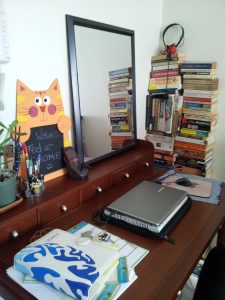Starting with an outline can feel like an extra step, but for any writer—especially if we’re new to the process of crafting a creative nonfiction essay—an outline is like a roadmap that guides our creativity. Memoir is creative nonfiction, so creating an outline can be particularly useful in finding a balance between storytelling and factual events. Instead of locking us in, a good outline lets our ideas flow freely, keeping our work focused while still allowing room for inspiration.
Why Create an Outline?
As writers, we might think that outlining limits our creativity, but it’s the opposite. Creating an outline is like sketching an artwork. It gives our ideas a shape without filling in every detail. With a rough structure on the page, we can see where our ideas are headed and discover moments of creativity. This is especially true in a creative nonfiction essay, where balancing facts with creative storytelling is essential.
But how do we create an outline? To begin, we can jot down the main idea or theme we want to explore in our creative nonfiction. Let us not worry about perfection; our goal is to get a sense of direction: to write down anything that comes to mind, even if it seems disconnected—we’ll refine it later.
Build the Creative Structure
Once we have pinpointed our main idea, we can break it into sections. We can also add sub-points under each section. Remember that even this structure should remain flexible. If we get an exciting new idea later on, we should adjust the outline. This flexibility is the page a writer often returns to, fine-tuning it as the work progresses.
A Sample Outline Created for a Theme
MY FIRST JOB
I. Introduction: First Day Impressions
- Describe first impressions of the office environment
- Meet new colleagues, feelings of excitement and nervousness
II. Learning the Ropes
- First tasks and early mistakes
- Mentorship and guidance from a senior colleague
- Moments of self-doubt and small victories
III. Building Confidence and Skills
- Challenges that led to growth
- Taking on more responsibility and gaining confidence
- Memorable projects or milestones
IV. Memorable Colleagues and Workplace Culture
- Funny or impactful stories about coworkers
- Company traditions, team-building activities, or office dynamics
- Lessons learned from the diversity of personalities
V. Reflections and Takeaways
- How the job shaped your career perspective
- Life lessons or skills gained that are valuable today
- Transitioning from the job and looking back on it now
Adding Creative Details
When we’re confident about our structure, let’s begin thinking about what other elements to add—our unique perspective, unexpected turns, or other little moments that will bring our creative nonfiction to life. Our additional notes should remind us of where these elements could fit.
Reviewing and Adapting our Creation
Before we start drafting, let us study our outline and ask: is it balanced? Are there areas where we can be more creative? Let us remember that our outline is a tool, not a rule. Our outline should evolve even as we continue writing.
An outline gives us a foundation that allows our ideas to grow and transform, keeping us inspired and on track. Especially when working on a creative nonfiction essay or memoir, we can’t go wrong with a mapping of our ideas for more artful expression.




